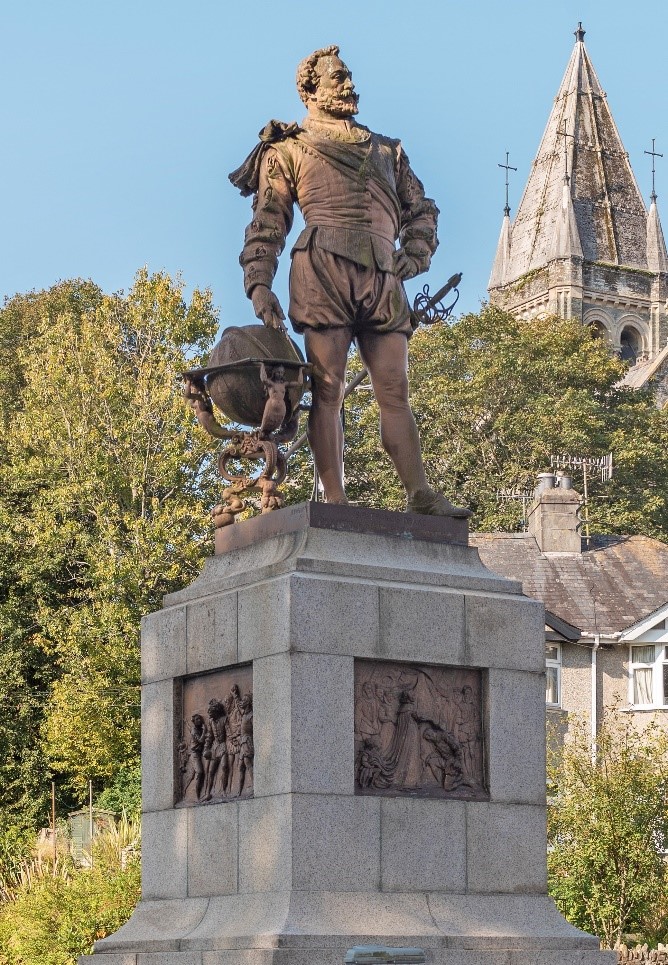
In 1882 a civic delegation from the Mayor of Plymouth arrived in Tavistock to raise funds to erect a statue to Sir Francis Drake on Plymouth Hoe in readiness for the 300th Anniversary of the defeat of the Spanish Armada in 1588.
Incensed at the idea that the Plymothians were attempting to steal Tavistock’s famous son, the worthies of Tavistock led by Rev Edward Spencer, headmaster of the Grammar School, agreed to start a fund to raise money for a bronze statue of Drake.
Before they could launch their appeal, Hastings Russell, the Ninth Duke of Bedford, offered to pay for the statue as a gift to the town.
The Duke commissioned the Austrian born sculptor, Joseph Edgar Boehm (1834 -1890), who was a member of the Royal Academy and sculptor-in-ordinary to Queen Victoria.
Various sites for the statue in Tavistock were considered, including Bedford Square, the Meadows and Fitzford. Boehm thought that Fitzford would showcase his work to best advantage where it would be within view of Crowndale where Drake was born.
The 10ft high statue, which had been cast in Surrey, came by train to Tavistock on Friday 21st September 1883 and remained at Tavistock South station overnight. At 6.00 am the following morning, it was taken the half mile to Fitzford. The two tons of metal were hoisted into position and a sheet was thrown over the statue to await the official opening fixed for the following Thursday, September 27th.
After a prayer and speeches, the statue was unveiled, followed by a lunch for the dignitaries at the Town Hall. The whole town enjoyed music and dancing in the Pannier Market Hall, and an athletics event in a field behind the Fitzford Cottages.
Five months after the statue was unveiled in Tavistock, a copy was erected on Plymouth Hoe in early 1884 without the bas reliefs.
In 1885, railings were added around the pedestal after vandals broke Drake’s sword and drunken railway navvies had taken to sleeping off their heavy drinking bouts on the steps below.
In 1999, the original plaster model for the statue was found hidden in woods on Haldon Hill, near Exeter. It was transported to Buckland Abbey where it was repaired and is now on permanent display.
The Panels Around the Statue
On three sides of the Tavistock statue’s plinth are bronze bas reliefs depicting key moments in Drake’s career.
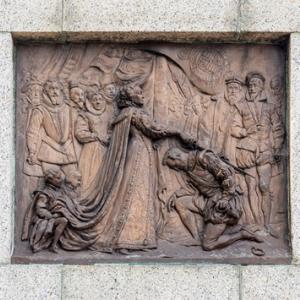
4th April 1581 – Drake is knighted at Deptford
Five months after his voyage around the world the
Golden Hind was brought to Deptford where the
Queen Elizabeth I met him.The Queen stood on the
deck of the Golden Hind and, having handed her state
sword to the French Ambassador to actually perform the
ceremony, bestowed the accolade of the knighthood on
Francis Drake.
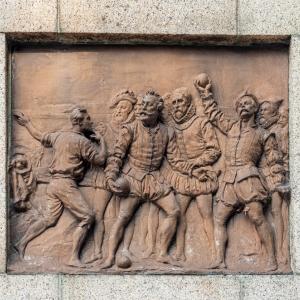
19th July 1588 – Drake finishes His Game of Bowls
An unproven story tells that when Drake was told of the
approach of the Spanish Armada, he insisted that he had
time to finish his game and then finish the Spanish fleet.
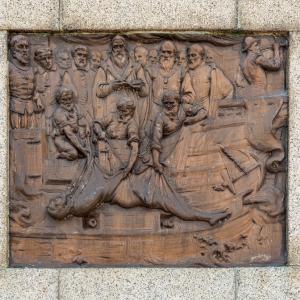
29th January 1596 – Drake’s Burial at Sea
Drake died of dysentery off Panama.
His body, dressed in full armour and sealed in a lead coffin
was buried at sea about three miles off shore
from the port of Portobelo.
The plaque fails to show the coffin.
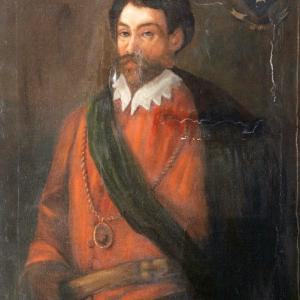
Who was Drake?
Sir Francis Drake is an iconic figure – a man of his time whose achievements and exploits in the second half of the 16th century helped to lay the foundations of Britain’s historical maritime power. However, his involvement in both privateering and the early slave trade reveal a darker side to the seafaring heritage of the Tudor age.
Early Life
Francis Drake was born at Crowndale, on the outskirts of Tavistock, in around 1542. His father, Edmund Drake, was a tenant farmer for Francis Russell, 2nd Earl of Bedford. In 1548 when Drake was still a child, his father was charged with assault and robbery and the family left Tavistock for Chatham in Kent. Growing up on the River Medway, Drake learnt his maritime skills having been apprenticed aged 12 to a local ship owner.
By his early 20s, he had become a master mariner and moved from Chatham to Plymouth to work for his kinsmen, the Hawkins family, who owned a successful merchant fleet.
The English had become aware of the riches of the New World and the Spanish and Portuguese use of African slave labour. John Hawkins, would become the first Englishman to establish a slave trading venture, beginning Britain’s contribution to over 400 years of the transatlantic slave trade in which 12 to 12.8 million Africans were shipped across the Atlantic.
Introduction to the Slave Trade
Between 1562 and 1568 Drake sailed on three of Hawkins’ slaver expeditions to Guinea and Sierra Leone with the last two voyages part-funded by London merchants and sanctioned by Queen Elizabeth I who even provided Hawkins with two of her warships.
The voyages involved attacks on villages along the African coast often with the help of rival tribal chieftains. Whole communities would be kidnapped and taken on board the ships and transported en masse and in terrible conditions to the West Indies to be sold to the Spanish to work on plantations and in the silver mines of South America. Hawkins was able to add to his tally of slaves by attacking Portuguese slaving ships at sea and stealing their cargoes. It is estimated that between 1,200 and 1,400 Africans were enslaved by Hawkins and his crew, many of whom died before they even reached their destination. It is estimated that the actions of Hawkins and Drake would have involved killing at least three times that number of people, based on slavers’ accounts of the time.
Drake and Hawkins’ third slaving expedition ended when a flotilla of Spanish ships ambushed their ships at the Mexican port of San Juan de Ulúa, destroying four of their vessels and killing or capturing many of their crew. Drake escaped unharmed, but the defeat left him with a seething hatred for Spain and its king, Philip II.
The Privateer
Drake never engaged in slave trading again, but instead focussed his attention on attacking the Spanish. Between 1570 and 1572, with the unofficial approval of the Queen, he sailed as a privateer with two ships and a small crew made up of men from Plymouth and Tavistock raiding the coast of the Spanish Main plundering ports and seizing ships.
During one of his attacks at Nombre de Dios, off the coast of Panama, an escaped African slave called Diego came to warn Drake that soldiers were on the way, and to seek refuge from his Spanish masters aboard Drake’s fleet. Diego introduced Drake to the Cimaroons, a group of escaped African slaves living in the jungle. Using them as guides, he was able to ambush mule trains transporting silver from the Pacific to the Caribbean coast and in the process brought back untold amounts of silver and treasure. Diego returned with Drake to England and continued to sail with him on his future expeditions.
Circumnavigation of the World
In 1577, the Queen commissioned Drake to sail into the Pacific Ocean via the Strait of Magellan and investigate the extent of Spain’s colonisation along the west coast of the Americas. He left Plymouth with five ships, but only one, the Pelican, was sturdy enough to make it through the Straits to the Pacific.
Drake renamed the Pelican, the Golden Hind, in honour of his patron, Sir Christopher Hatton, whose crest featured a ‘golden hind’. Once in the Pacific, Drake sailed northward pillaging Spanish settlements, capturing ships and charting the unknown west coast of North America.
As he travelled up the American west coast, he landed in California, north of the northernmost Spanish settlement at Point Loma (San Diego). He named the landing site Nova Albion and claimed the region for England. He carried on further north in search of the fabled North West Passage, but having reached Vancouver decided that it may indeed have been a fable and so turned south again to rest and restock, before sailing across the Pacific to the Spice Islands and home again by way of the Cape of Good Hope.
On the 26th September 1580, he returned to Plymouth, the first Englishman to sail his ship right round the world and only the second circumnavigation in history. For his achievement, and for the vast treasures he brought back with him, Queen Elizabeth knighted him.
Life ashore
For a while, Drake enjoyed his life and his treasures on shore. He bought Buckland Abbey, just four miles south of Tavistock, from Sir Richard Grenville. In 1581, Drake was elected Mayor of Plymouth and served as an MP. His wife Mary died in the same year and in 1585, he married Elizabeth Sydenham.
The Armada
By 1585 Spain and England were officially at war and Drake was ordered to lead an expedition to attack the Spanish colonies. He left Plymouth in 1585 with a fleet of twenty-one ships.
He first attacked Vigo in Spain and then plundered Santiago in the Cape Verde islands. After this the fleet then sailed across the Atlantic, sacked the port of Santo Domingo, and captured the city of Cartagena de Indias in present-day Colombia. En route home he raided the Spanish fort of San Agustín in Spanish Florida, then sailed further north to the failed English settlement of Roanoke rescuing the stranded colonists. He finally reached England on 22 July, when he sailed into Portsmouth, England to a hero’s welcome.
By this point the Spanish had taken to calling Drake “el Draque” – the Dragon. Some Spanish mariners were so afraid of him, that they believed he practised witchcraft and possessed a magic mirror that allowed him to see the location of all the ships in the sea.
In 1587, word reached Queen Elizabeth that King Philip of Spain was planning an invasion of England, to avenge the death of the Catholic Mary Queen of Scots.
Drake was sent to sea again to disrupt their plans.
In 1587, he sailed to the port of Cadiz in Spain and set fire to the ships of the gathering Spanish naval forces, before raiding forts along the Portuguese coast. This delayed Spain’s invasion of England by a whole year, an intervention that became known as ‘singeing the King of Spain’s Beard’.
By 1588 the Spanish Armada, a fleet of 130 ships, sailed to invade England and overthrow Queen Elizabeth I. They intended to destroy the Protestant faith and stop English privateers’ raids on their fleets.
Queen Elizabeth appointed Drake as second in second-in-command of the fleet. The English ships sailed from Plymouth to attack the Armada and Drake himself was able to capture of the Spanish flagship, Nuestra Señora del Rosario.
When the Armada attempted to regroup off Calais, Drake organised a night-time fireship attack causing mass panic amongst the Spanish.
There followed an immense naval battle during which the Spanish fleet were bombarded by the long-range English guns. They finally retreated with many Spanish ships swept into the North Sea by storms and then wrecked on Scotland and Northern Ireland’s coasts. The Armada had been defeated.
Drake’s Leat
Back in Plymouth in 1589, after an unsuccessful attack on Lisbon, Drake became involved in a major project to improve the city’s water supply through the construction of an 18½-mile leat from the River Meavy on Dartmoor. He also built six water-driven corn mills along it. Water from the leat and flour from his mills supplied the fleets leaving Plymouth.
The last Voyage
Drake’s seafaring career continued for another eight years until he caught dysentery whilst attempting to capture the rich port of Panama.
Before dying, he asked to be dressed in his full armour. He was buried at sea in a sealed lead-lined coffin, near Portobelo, a few miles off the coastline.
Despite numerous dives to find his coffin, his body remains lost at sea.
The content of an Interpretation Board which was agreed to be erected by the Town Council in 2020/21 setting out key aspects of Drake’s life and achievements can be viewed here:
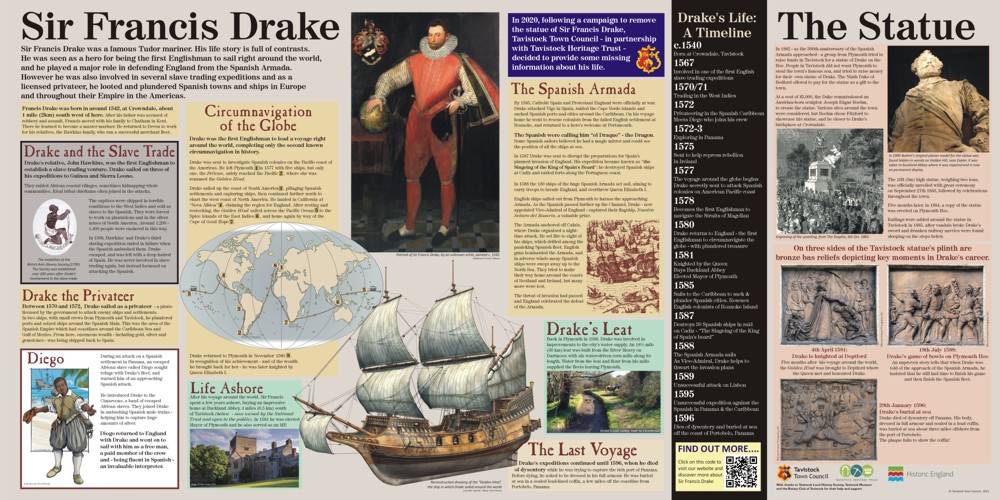
“Frequently Asked Questions” about the Interpretation Board for Drake’s Statue can be viewed here:
Further information on Sir Francis Drake and the Transatlantic Slave trade can be found via the weblinks below
Historic England the Slave trade and abolition
Royal Maritime Museum Sir Francis Drake
Learn more about the origins of the transatlantic slave trade
Bibliography of historic sources in preparation of the Interpretation Panel

